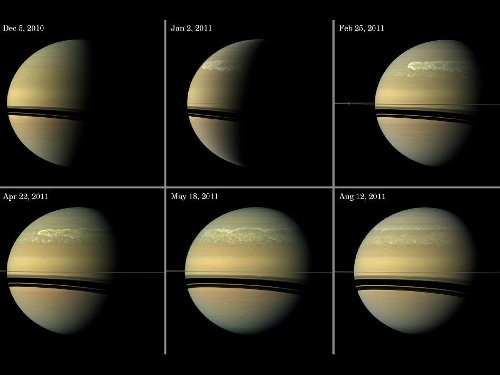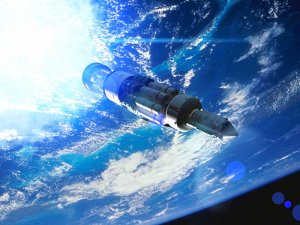Centauri Dreams
Imagining and Planning Interstellar Exploration
Notes & Queries 11/21/11
Millis on The Space Show
Marc Millis is now in Brussels for another TEDx talk — I link here to the TEDx description of him as ‘a rock star in the world of space geeks’ that always gives him a chuckle. More about the talk as soon as I have the link for online viewing. All this reminds me to tell you that Marc and I were guests on David Livingston’s The Space Show last week, with the MP3 now available at David’s site. Although we did kick around some interstellar propulsion concepts, particularly in the call-in segments, we spent most of the time talking about Tau Zero and the 100 Year Starship project. If you want to hear about the nuts and bolts of Tau Zero including the interesting and developing university affiliations, check out the two-hour podcast. David is a superb interviewer.
SF and the Sublime
Gregory Benford recently posted Peter Nicholls’ Big Dumb Objects and Cosmic Enigmas, a talk delivered in 1997 aboard the Queen Mary (now anchored at Long Beach, CA) on his site. Given the number of comments the recent science fiction discussion here has generated, it seems a good time to point to what Nicholls has to say. His ‘big dumb objects’ are vast alien artifacts, and he wants to relate them to what has always been called the ‘sense of wonder,’ a much abused term that describes our reaction to science fictional settings and situations. But let him describe what he’s about:
There is in science fiction, even or especially (as I will argue later) in so-called Hard science fiction, something which in other context we tend to think of as unscientific, be it called sense of wonder, or the sublime, or the transcendent as the Panshins have it, or the romantic. And one rather mechanical way of creating this effect is for the storyteller to imagine something very very big and mysterious, like the spaceship Rama, or like Larry Niven’s Ringworld. That is, the mysterious something in science fiction often has its locus classicus in the Big Dumb Object.
Now you can think of a lot of science fiction that fits this description, and Nicholls treats many of these titles, enough to give you a good holiday reading list and more. Gregory Benford’s Galactic Centre series is here, along with Bob Shaw’s Orbitsville and James Blish’s Cities in Flight. From Greg Bear (Eon, Eternity, Legacy) through Paul McAuley (Eternal Light) and Charles Sheffield (Summertide), he explores the tension between the familiar and the deeply strange ‘otherness’ of these tales, which becomes a kind of transcendence that transports the reader and opens up new ways of seeing the world. In the passage below, he contrasts his own reaction to such works with that of fellow editor John Clute, who worked with him on The Encyclopedia of Science Fiction (2nd ed., 1993 and now available in a beta 3rd edition online):
So we’re reaching a more sophisticated view of what space fiction in general and BDO fiction in particular tends to be about. It is about being dwarfed by space and hugeness, about attempting to maintain our own humanity, warts and all, in the light of this vastness, while at the same time yearning to be better or other than what we are. And this is not a theme that is intrinsically scientific at all, which makes it all the odder that it is in the hardest and most scientific sf that we tend to find the purest examples. I believe that what drives some of us to be scientists in the first place is an unusual openness to the sort of experience-or perhaps I should say the sort of feeling-that I’m clumsily and not very successfully trying to pin down. My own training is in both the sciences and the arts, though I should say the scientific bit in its formal manifestation was a long time ago. John Clute’s training is in the arts only. I’ve wondered at times whether my greater sympathy for certain kinds of science fiction, and my lesser sympathy for some other kinds, might not be a result of this early imprinting. I probably exaggerate.
I had never encountered Nicholls’ essay before and I commend it to you. He sees the writers of hard science fiction as not less but more romantic than their colleagues in ‘softer’ science fiction, finding the romantic element in the metaphors of deep space, which include the alien artifacts under consideration here. It’s certainly true that ‘big dumb objects’ — here I’m thinking specifically of Larry Niven’s star-encircling Ringworld, can so rattle our preconceptions that they do evoke that sense of the sublime that early 19th century writers and artists found in places like the Alps. Science fiction is not our only ticket to transcendence but the best of it does evoke the enigma of contact with things so far beyond ourselves that they partake equally of science and art.
Stormy Times on Saturn
Storms on gas giants are awe-inspiring events, as witness what has been happening on Saturn since December of 2010. For a year now a monster storm extending 15000 kilometers north to south has been pummelling the northern latitudes. The Cassini images below takes us back to the earliest trace of the storm on December 5, 2010 and follow it through the middle of 2011, with views acquired at distances ranging from 2.2 million kilometers to 3 million kilometers.
Image: This series of images from NASA’s Cassini spacecraft shows the development of the largest storm seen on the planet since 1990. These true-color and composite near-true-color views chronicle the storm from its start in late 2010 through mid-2011, showing how the distinct head of the storm quickly grew large but eventually became engulfed by the storm’s tail. Credit: NASA/JPL-Caltech/Space Science Institute.
This is the longest lasting storm of this kind ever seen on Saturn, and it’s a far cry from the kind of weather we see on Earth:
“The Saturn storm is more like a volcano than a terrestrial weather system,” said Andrew Ingersoll, a Cassini imaging team member at the California Institute of Technology in Pasadena. “The pressure builds up for many years before the storm erupts. The mystery is that there’s no rock to resist the pressure – to delay the eruption for so many years.”
What we’re learning about Saturn’s weather is that major storms come in outbursts separated by 20 to 30 years, which suggests a mechanism deep inside the planet that remains unknown. More in this CICLOPS news release.

Science Fiction and the Interstellar Idea
Science fiction has been much on my mind of late, particularly following the 100 Year Starship Symposium, where so many of the scientists I talked to mentioned novels and movies that had been influential in getting them into science. My friend Keith Cooper, editor of Astronomy Now and a fine science writer whose work I often cite in these pages, also shares an interest in SF, and it was natural enough that we fell into a conversation by email on how the genre relates to interstellar studies. Because while we would expect a natural synergy between science and science fiction, the genre’s cinematic and literary treatments are often at variance with each other. Why is this, and why are some elements of the interstellar idea easier to explore in writing than in film? Here are some thoughts (and memories) about science fiction’s role.
- Paul Gilster
Keith, you and I are both science fiction readers, although I’m enough old that I grew up in the heyday of Heinlein and all those great books for young people. I remember being in a book fair at my grade school where each class had tables set up with books that were considered appropriate for that grade level. I was in about third grade at the time, but I wandered over to the sixth grade table because I saw a hardcover copy of Heinlein’s Citizen of the Galaxy. I can still see that book’s cover, and feel the effect of that odd juxtaposition that Heinlein opened with — slavery in a far future society. At that point in my life, slavery was one of those things that were safely in the past, but of course Heinlein played with a lot of our expectations, as does SF in general.
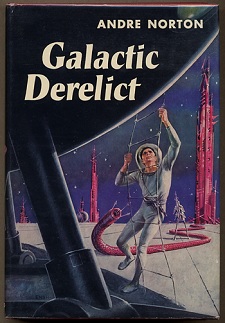
I could muse on some of those early readings for a long time, but the other one that really lit up for me was Starman Jones, in which I learned the term ‘astrogation’ and started to think seriously about ships that went between the stars. Right around the same time I found Andre Norton’s Galactic Derelict — can still recall the cover of that one, too, and the vistas it opened up to me. The list goes on and on, but maybe you can see why I’m sort of dismayed by the current emphasis on movie science fiction. In fact, when I mention SF to a lot of people, the response almost automatically refers to cinematic treatments. I’ve always enjoyed these but found them far less compelling than science fiction in actual books! But then, I’m a bit of a throwback. I still enjoy listening to old radio shows more than watching contemporary television programming.
I’d like to get your read on an idea that Geoff Landis told me about when I interviewed him for Centauri Dreams some years ago. We had been talking about his book of short stories called Impact Parameter and Other Quantum Realities, in which there is a story about an all-female crew on its way to Delta Pavonis. It’s a two-decade trip, as I recall, and conditions aboard the ship are cramped to the point of excruciation. How the crew finds the will and the mental fortitude to make it through the journey are what the Landis story is about, but it’s also a meditation on a key idea, that interstellar journeys may well be possible one day, but that they’re going to be long and hard under the best of circumstances.
But talk to the general public about star journeys and you basically get the same thing: Star Trek. I sometimes wonder whether science fiction as shown on television and in the movies hasn’t completely over-emphasized the far future possibilities at the expense of a more realistic approach. Wouldn’t it be interesting to tell the SF story — or make the SF movie — that tried to be as credible with the science as Destination Moon was when dealing with a lunar journey? I for one would love to see a movie version of the attempt to build an enormous sail for beamed propulsion, or someone’s read on a true Bussard ramscoop vessel. Hollywood is supposed to be where all the imagination is, so why have all the SF starships been so similar to each other?
- Keith Cooper

Paul, I think part of the problem is that in Hollywood they look at spacecraft the same way I look at cars: they go for an aesthetic but don’t really understand what goes on underneath the hood. I remember J Michael Straczynski once commenting that police officers, lawyers and doctors are hired to advise on police, courtroom or medical/forensic dramas, but they rarely use scientists or genre authors on science fiction shows or movies. I’d love to see a big budget movie featuring interstellar travel using nuclear fusion, microwave beaming and solar sails as advised by someone like Marc Millis or Kelvin Long.
Straczynski’s Babylon 5 was my favourite show as a teenager, and still is. He gave us a station that rotated to create the effect of gravity via centrifugal force, just like an O’Neill colony. The massive Earth cruisers had rotating mid-sections, and the Starfury fighters featured four-pronged vectored thrust multi-engines that NASA have optioned as a possible real-life design in the future. In contrast to B5’s alien spacecraft, the human spacecraft had well thought out designs and made space flight look a little more difficult than is usually portrayed on TV. This is a theme I want to pick up on.
Recently there appeared an article on the Tor website entitled A Moral Argument for Hard Science Fiction by Madeline Ashby. She talks about the inaccurate depiction of computers and computer hacking on the big screen, placing them in the broader context of the general lack of understanding of science amongst the public and politicians. To quote from her article:
“Me, I blame Hackers. I don’t mean actual hackers. I mean Hackers, the 1995 piece of bad William Gibson fan-fic about kids who save their haxx0r reputations with rollerblades and holograms. And with it I’d like to blame all other depictions of hacking as easy, technology as simple, and science as the work of solitary geniuses awaiting quick flashes of divine inspiration.”
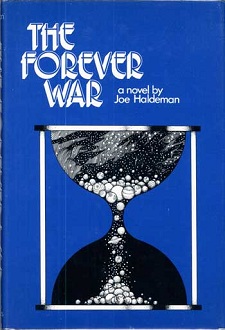
If we substitute ‘interstellar travel’ for the word ‘hackers’ I fear the problem still stands. Space travel is part of the furniture of SF and we need it to voyage to wondrous new worlds, but at the same time it can seem too easy. I love Joe Haldeman’s The Forever War for showing that the consequences of relativistic space travel can be difficult for the characters as they return home from each mission finding that time on Earth has progressed without them.
However, written SF can gloss over the realities of building starships too. In Peter F Hamilton’s Commonwealth Saga, a human civilisation that has had wormhole technology for hundreds of years (railroads passing through wormholes link planets, which is ingenious) builds its first starship to investigate a Dyson Sphere. After they become embroiled in an interstellar war with the denizens of the Dyson Sphere, the Commonwealth quickly start building bigger, better and faster starships, seemingly at will. I adore Hamilton’s work but the process of building the new starships seemed too easy to me. E E ‘Doc’ Smith used to do the same thing in his Lensman series.
I’m now in a quandary Paul. I love to watch the adventures of Han Solo or Captain Kirk galivanting around the Galaxy, but at the same time I yearn for more science over fantasy. What examples of SF are there that strike the right balance and depict space travel as something that is hard but achievable with effort, while yet continuing to have exciting adventures on strange new worlds?
- Paul Gilster
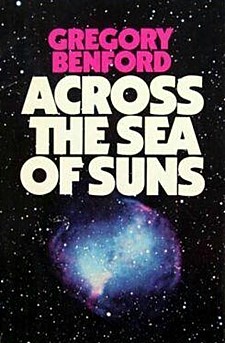
As I expected, Keith, we have many of the same enthusiasms. I do enjoy video treatments of science fiction but on a somewhat different level than written SF, but hey, I get a kick out of going back and reading old issues of Science Wonder and some of the early Astoundings as well. There’s something about that era and the way it interacted with the then current concept of the future that mesmerizes me. Anyway, we seem to be in a time when hard SF, with more emphasis on the science, is again competitive with the other strains of the genre. I am a great devotee of Gregory Benford’s work and think the Galactic Center series is the best treatment of the far future I’ve encountered. I have wonderful memories of the novella in IF back in 1972 that started it all off.
But maybe you’ve read Robert Forward’s Rocheworld, or the earlier, shorter work it was based on called Flight of the Dragonfly. Forward is one of my heroes for the insights he has given us into interstellar flight using known physics, but his fiction clanks a bit in terms of characterization even if the ideas he plays with are the kind of thing we discuss every day on Centauri Dreams. I’m betting laser sails and antimatter rocketry with a scrupulous attention to the physics are turning up in modern science fiction without my knowing it, because I’ve been so busy in the past ten years with the kind of work I’m doing now that I haven’t had the chance to keep pace with the field. We’re lucky here because the readers have always come up with book suggestions. Let’s see what they say.
Madeline Ashby makes sense to me, especially when she talks about depictions of hacking as “easy, technology as simple, and science as the work of solitary geniuses awaiting quick flashes of divine inspiration.” I don’t know about the hacking part because I’m not of the hacker mindset (though I envy people who hack in the true tradition of the world, meaning that they really get to understand how their computer and software work), but as far as science goes, when we depict the solitary geniuses waiting for inspiration, we’re not talking about a world that’s with us today. You look at major crowd-sourced projects like the Galaxy Zoo and realize how much science is being turned out by thousands of amateurs making a collaborative contribution. On the other end of the spectrum is something like the Large Hadron Collider, where vast numbers of highly-trained people turn up as co-authors on the papers generated by this enormous project.
The solitary inventor was the norm in Edison’s day, perhaps, but we see little of this today. I wouldn’t want to discourage anyone with a breakthrough idea, but we also need science fictional depictions of the way science works in today’s era of the particle accelerator and the federal grant. One of the things Greg Benford brings to the table is his intimate relationship with science through his own work in physics. He knows how the process works, where it is frustrating and where it can be exhilarating, and he’s done enough experimental physics to know how thorny are the problems of gaining the needed funding. But bear in mind that he and brother Jim have also found ways to test microwave beaming on a sail in a laboratory at relatively low cost, so this kind of thing does get done. I’d like to see more science fiction coming out of that kind of lab work.
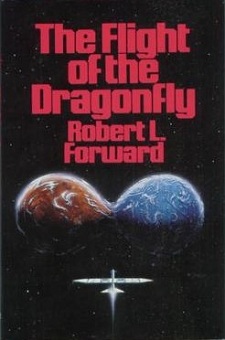
As for movies, maybe James Cameron can be prevailed upon to try a different kind of starship one of these days. Or maybe Ridley Scott? Because if we’re talking movies, I’d love to see either of these men work up a screen treatment of Forward’s ideas in Rocheworld, taking a laser sail mission all the way to Barnard’s Star and solving the complex issues involved in deceleration and exploration. There’s a screen epic crying out to be made, and along the way it would introduce the general public to the concepts of interstellar flight by non-magical means.
Say, did you know that Isaac Asimov’s Foundation trilogy (I call it a trilogy because the next three novels came much later and I have to say I’m ambivalent about them) has been kicking around in the planning stages for one or another film studio for some years now? It would be fun to see what Hollywood made of it, but I’m a bit burned out with far future epics. Tell you what, let’s lobby for a beamed sail movie, and maybe also for Geoff Landis’ Mars Crossing to turn up in a movie version. We’d get two movies, one near-term, one much further out, each with an impeccable scientific pedigree. In the right hands, the results could be mesmerizing. How say you?
- Keith Cooper
Believe it or not Paul I’ve yet to read Benford, Landis or Forward; I’m well aware of their work but haven’t got around to them yet. Instead I’ve been ploughing through the ‘golden generation’ of UK SF authors from the past 20 years, such as Hamilton, Stephen Baxter, Alastair Reynolds, Richard Morgan, Iain Banks, Neal Asher and others. British SF currently has a lot going for it and I strongly recommend these authors to you. What I would say, however, is that among this clutch of British authors I think there is a tendency to focus more on world-building with lots of great plot ideas exploring a range of issues from the social to the cosmic, rather than any urge to delve too deeply into the mechanics of spaceflight. There are exceptions of course, such as Stephen Baxter, and although I don’t think there is much wrong with the current direction of UK SF, that pioneering spirit of space travel so evident in the novels you describe Paul does seem to be sometimes missing.
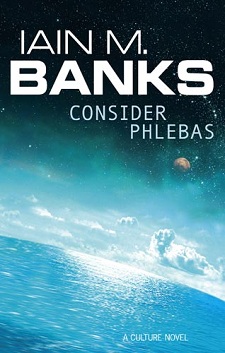
What strikes me about your description of Landis’ and Forward’s work makes me think they rather enjoyed doing the calculations to make their space travel realistic. Certainly it is no coincidence that the trio of authors you mention all have an academic science background, allowing them to reach the rigorous level of detail required to not only fully get to grips with the propulsion systems they deploy in their books, but also derive fresh new ideas.
We may ask, how many of the creative types in Hollywood are tuned into where SF is pushing the envelope today? So much of Hollywood’s output seems to be 20 or 30 years behind the current trends in written SF. Perhaps what is needed is for some SF authors to cross the divide. Robert Sawyer, for example, has done it somewhat on television with the likes of FlashForward, but let’s see more. I don’t know if it is a reluctance on the side of the authors, or whether Hollywood is a closed-shop, but rather than making movies based on books without the involvement of the authors, let’s see some SF authors team up with a director and be given the opportunity to write an original script for Hollywood.
I’m not sure who that director could be – the idea of a Foundation movie potentially helmed by Roland Emmerich fills me with dread, James Cameron’s Avatar was more fantasy than hard SF, and as great as Alien and Bladerunner are, Ridley Scott has not displayed any empathy for hard SF (although he has picked up the rights to The Forever War, which if done right could make for a tremendous film). Perhaps Ron Howard, with his experience on Apollo 13, might be a good choice, or some other up and coming director?
Science fiction is perhaps the first, best testbed for future technologies. In its pages we can play out where these technologies can take us, the riches they can give us and the risks they pose. To continue to do so, we need more scientists with a passion for the genre and an eloquence to their prose to introduce us to detailed new ideas. The authors who follow them can then be let loose with these concepts, like kids in a candy store, picking ideas off the shelf and running with them, placing them in new and exciting settings. This is how SF has always operated, from Stapledon to Clarke to Baxter, or Asimov to Niven to Banks to the next generation of authors – where will they take us next?
- Paul Gilster
PG: We can only imagine where they’ll take us next. I see we’re both in heavy reading mode. Lately I’ve been going back to some of the classics and refreshing my memory, most recently with Asimov’s first three Foundation books, which is why the subject was on my mind earlier. And I see you’re deep in the Hamiltons, Baxters and Reynolds of this world. What’s happened to me is that many of the readers of Centauri Dreams have suggested authors — this is how I started reading Alastair Reynolds and Iain Banks, and although I haven’t gotten into his work yet, I’ll use your suggestion (and I’ve heard it from others) to start reading Peter Hamilton.
I always get a kick out of learning about authors that are new to me, and you’ve mentioned several in this exchange that I’ll need to get to know. Interstellar flight has always gotten us straight into the science fiction element because there are so many unknowns, so many approaches, and we can let the concepts fly in fiction and see where they lead us. The number of physicists and engineers who have related what they are doing to earlier science fiction novels and short stories is, well, astounding, and tells us that SF will always play the role you describe, as testbed for both scientific ideas and philosophical speculations. Let’s keep the lines of communication open as we both discover new authors and range through their universes.

A Possible Subsurface Lake on Europa
An area of disrupted terrain called Thera Macula on Jupiter’s moon Europa may be evidence for a body of liquid water with the volume of North America’s Great Lakes encased within the ice. The notion comes from analysis of floating ice shelves that seem to be collapsing. That an ocean exists beneath the ice on Europa should surprise no one, but what is significant about the recent findings is that they suggest a way to exchange nutrients and energy between the surface and the ocean beneath. Such a mechanism changes the nature of the speculation about whether Europa’s ice is thick or thin. The case for astrobiology always seemed stronger if the ice were thin, but it seems that ways to exchange material with the surface may exist in either scenario.
At least that’s what this intriguing finding suggests. Britney Schmidt (University of Texas at Austin) is lead author on the paper that appears online in Nature:
“One opinion in the scientific community has been, ‘If the ice shell is thick, that’s bad for biology’ — that it might mean the surface isn’t communicating with the underlying ocean. Now we see evidence that it’s a thick ice shell that can mix vigorously, and new evidence for giant shallow lakes. That could make Europa and its ocean more habitable.”
When you work with Europa, you’re relying on images taken by the Galileo spacecraft, focusing in this case on two bumpy features in the disrupted topography that scientists call chaos terrain. The area known as Thera Macula shows evidence of active resurfacing of ice over a large body of water. Evidence that such terrain can still be forming is good news for those hopeful for life beneath the surface. The speculation is that many such lakes may exist throughout shallow regions of Europa’s shell, many of them covered with similar collapsing ice shelves.
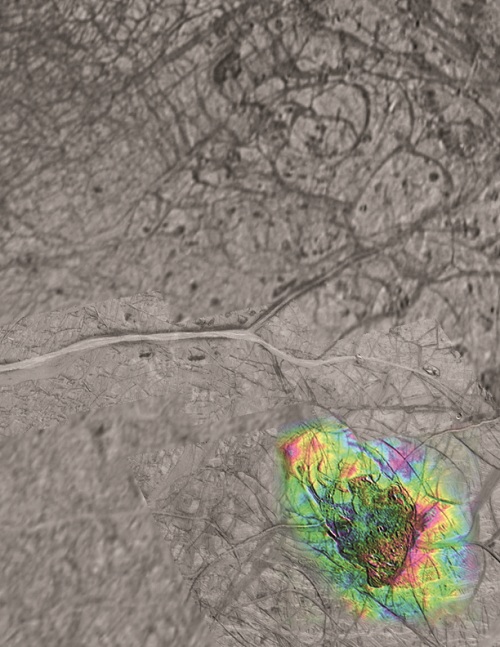
Image: Thera Macula (false color) is a region of likely active chaos production above a large liquid water lake in the icy shell of Europa. Color indicates topographic heights relative to background terrain. Purples and reds indicate the highest terrain. Credit: Paul Schenk/NASA.
The researchers worked with Galileo data and applied processes observed here on Earth in areas where ice shelves are in motion and volcanoes are found beneath overlying glaciers. Their work indicates that chaos terrains “… form above liquid water lenses perched within the ice shell as shallow as 3?kilometres. Our results suggest that ice–water interactions and freeze-out give rise to the diverse morphologies and topography of chaos terrains.” All of this means that nutrients and energy may be available in the deep ocean, but we won’t know for sure until we can develop a mission that is designed to probe beneath the ice. The same kind of radar instruments that study Earth features within ice can be adapted for such a spacecraft.
The paper is Schmidt et al., “Active formation of ‘chaos terrain’ over shallow subsurface water on Europa,” published online in Nature 16 November 2011 (abstract).

Updating the Gravitational Wave Hunt
The Laser Interferometer Space Antenna mission (LISA), slated for launch later this decade, will go about testing one of Einstein’s key predictions, that gravitational waves should emanate from exotic objects like black holes. Detectors like the Laser Interferometer Gravitational Wave Observatory (LIGO) have operated on Earth’s surface but are subject to seismic noise that disturbs the observations in some of the key frequency ranges. The hope is that the space-based LISA will be able to go after the low-frequency gravitational wave spectrum to detect such things as the collision of black holes, the merger of galaxies or the interactions of neutron star binary systems.
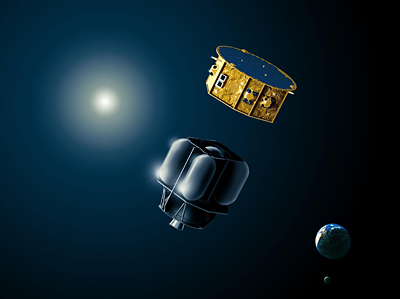
The good news out of the European Space Agency is that the LISA Pathfinder precursor mission, planned for a 2014 launch, is showing the accuracy needed to demonstrate what the more sophisticated LISA mission should be able to do. LISA Pathfinder is a small spacecraft unable to make a direct detection of gravitational waves, but if all goes well it should be able to test whether objects moving through space without external influences trace out a slight curve — a geodesic — because of the effect of gravity upon spacetime. That would take us one step closer to the actual detection of gravitational waves using even more sensitive technologies in the full LISA mission.
Image: LISA Pathfinder will pave the way for the LISA mission by testing in flight the very concept of the gravitational wave detection. It will put two test masses in a near-perfect gravitational free-fall and control and measure their motion with unprecedented accuracy. This is achieved through state-of-the-art technology comprising the inertial sensors, the laser metrology system, the drag-free control system and an ultra-precise micro-propulsion system. Credit: Astrium.
The early results on LISA Pathfinder are promising. Detecting ripples in spacetime requires measurements with the accuracy of 10 billionths of a degree, yet thermal vacuum tests are revealing the spacecraft’s subsystems can produce this kind of performance. Under space-like test conditions with an almost complete spacecraft, LISA Pathfinder has been demonstrating a 2 picometer accuracy — a picometer is about a hundredth the size of an atom — and expectations are that once in space the observatory will be able to do even better.
Aboard the spacecraft will be two 4.6 cm3 test masses that will float within two chambers 35 cm apart in the core of the observatory. Their relative positions are to be tracked by a laser measuring system. Any gravitational disturbances should cause minuscule changes in their positions. Bengt Johlander, payload engineer for LISA Pathfinder, describes the system:
“We are seeking to keep the geodesic motion of our test masses as pure as possible. The masses are free to move – and if our experiment is set up correctly they should move together in concert – while the surrounding spacecraft is guided by their motion to follow in the same direction. It is impossible to have zero perturbations, but we have fixed a precise budget for disturbances we will stay within.”
The perturbations that must be avoided are vanishingly small, but any of them could compromise the experiment. They include solar radiation pressure, slight magnetic influences or vibrations from the body of the spacecraft and, remarkably, the internal gravitational pull of the spacecraft structure itself. LISA Pathfinder is to operate 1.5 million kilometers from the Earth at the L1 Lagrange point. The success of its systems paves the way for the later LISA mission, which will involve a trio of spacecraft flying 5 million kilometers part while linked by laser beams. ESA offers a useful backgrounder on LISA Pathfinder and the subsequent LISA mission. And be aware of this graduate level Web-based course on gravitational waves that Caltech makes available.

Can Project Orion Be Re-Born?
Project Orion keeps surfacing in propulsion literature and making the occasional appearance on the broader Internet. A case in point is a vigorous defense of Orion-style engineering by Gary Michael Church on the Lifeboat Foundation blog. Church is rightly taken with the idea of propelling payloads massing thousands of tons around the Solar System, but he’s also more than mindful of the realities, both political and economic, that have kept Orion-class missions in the realm of the theoretical. It was, after all, the nuclear test ban treaties of the Cold War era that brought the original project to a close, and anti-nuclear sentiment remains strong in the public today.
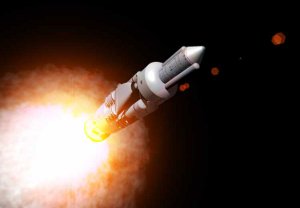
But the Orion idea won’t go away because it is so tantalizing. Church runs through the relevant information, much of it familiar to old Centauri Dreams hands. Freeman Dyson and Ted Taylor were working on a concept in which a large percentage of the energy of a nuclear explosion — these are small nukes of the kind Taylor specialized in — could be concentrated in one direction. If you can do that, you can blow that energy into a propellant slab to create thrust, assuming that a massive pusher plate would be present to absorb the blast without melting in the process.
Image: An Orion-class mission under power. Credit: Adrian Mann.
Remarkably, the research indicated that this was possible because the blast would last for such a tiny amount of time as the craft, boosted by each subsequent bomb, accelerated through space. It’s hard to describe what riding aboard such a craft would be like, though Church likens it to repeated aircraft carrier catapault launches. My own guess is that even the most highly advanced pusher plate/shock absorber combination would have trouble making this ride anything but a nightmarish if potentially survivable experience. But Dyson and Taylor had numbers showing that it was worth pursuing, and there were grand thoughts about shaking out an Orion-class mission back in the late ‘60s by going all the way to Saturn’s moon Enceladus.
Defending Orion Through Radiation
A defense of Orion will need to produce reasons for its resurrection, and Church offers several, beginning with the radiation that bathes deep space. Some kinds of cosmic rays pose a serious threat. From the essay:
The presence of a small percentage of highly damaging and deeply penetrating particles?—?the heavy nuclei component of galactic cosmic rays makes a super powerful propulsion system mandatory. The tremendous power of atomic bomb propulsion is certainly able to propel the heavily shielded capsules required to protect space travelers. The great mass of shielding makes chemical engines, inefficient nuclear thermal rockets, the low thrust forms of electrical propulsion, and solar sails essentially worthless for human deep space flight. Which is why atomic bomb propulsion is left as the only “off the shelf” viable means of propulsion. For the foreseeable future, high thrust and high ISP to propel heavy shielding to the required velocities is only possible using bombs.
It’s true that the bulk of the radiation we’ve so far had experience with in long-duration spacecraft has been more manageable, largely because a venue like the International Space Station is shielded by the Earth’s magnetic field. But as we start talking about multi-year missions, our thinking has to turn toward practical methods of shielding far beyond Earth’s orbit. Church sees the need for shields massing hundreds of tons that could hardly be propelled by conventional methods, whereas an Orion-style craft, bulking itself up with lunar ice deposits from the Moon’s north pole, could boost out of lunar orbit with a full and robust radiation shield. In his view, then, only Orion can take us on manned missions to other planets, much less the kind of interstellar missions sometimes contemplated for this technology.
But shielding a spacecraft, at least within the Solar System, may not be as demanding as this, as at least one space scientist believes. Robert Zubrin has been working out the basics of Mars Direct for some time now, and the radiation issue is a major concern for him as well. Where Church says “An appreciation of the heavy nuclei component of galactic cosmic radiation, as well as solar events, will put multi-year human missions beyond earth orbit on hold indefinitely until a practical shield is available,” Zubrin (in the latest edition of The Case for Mars) refers to this kind of talk as ‘scaremongering’:
Cosmic rays deliver about half the radiation dose experienced throughout life by people on the surface of the Earth, with those living or working at high altitude receiving doses that are quite significant. For example, a trans-Atlantic airline pilot making one trip per day five days a week would receive about a rem per year in cosmic-ray doses. Over a twenty-five-year flying career, he or she would get more than half the total cosmic-ray dose experienced by a crew member of a two-and-one-half-year Mars mission.
As the issue continues to be debated, we also have to look toward future interstellar missions, no matter what kind of propulsion system we commit to the task. If we’re talking human missions, it will clearly be essential to learn more about the shielding effects of the heliosphere on galactic cosmic rays to find out what kind of shielding will be needed for a crew that moves into interstellar space. Dana Andrews (Andrews Space), who has collaborated in the past with Zubrin on magsails, is just one researcher who has examined the issue. See his “Things to Do While Coasting Through Interstellar Space,” AIAA-2004-3706, 40th AIAA/ASME/SAE/ASEE Joint Propulsion Conference and Exhibit, Fort Lauderdale, Florida, July 11-14, 2004. You may find my article on Andrews’ work Dust Up Between the Stars helpful as well.
The Imperative of Species Survival
The real motivator for Orion technology may not be crew protection — much of our future work in the outer system and beyond may well be robotic — but the need to protect the planet from asteroids or comets on dangerous trajectories. This is Church’s ultimate justification, the one he hopes will trump the anti-nuclear lobby and bring clarity to the issue, and he points out that an Orion-class mission would be just the ticket if we had to send a human crew to an errant object deep in the Solar System to begin adjustments to its course. Thus this:
It is within our power to defend Earth from the very real threat of an impact, and at this time self-defense is the only valid reason to go into space instead of spending the resources on Earth improving the human condition. Protecting our species from extinction is the penultimate moral high ground above all other calls on public funds.
And this final thrust:
A powerful force of nuclear powered, propelled, and armed spaceships cannot guarantee Earth will not suffer a catastrophe. The best insurance for our species is to establish, in concert with a spaceship fleet, several independent self-supporting off world colonies in the outer solar system. The first such colony would mark the beginning of a new age.
Church’s essay is well thought out and deserves more attention than it seems to have been getting, considering that Orion gets us around problems like the harnessing of massive energies within an internal engine without melting the engine, something that uncontained nuclear-generated plasma and pusher plates could resolve. Of course, George Dyson explains all this in his wonderful account of his father’s and Taylor’s work Project Orion: The True Story of the Atomic Spaceship (2002), but I’m always thinking in terms of keeping deep space concepts in front of the public, and Church lays out the basics in ways that might attract a Net-reading generation familiar mostly with chemical rockets.
Image: An Orion vehicle departs for Mars. Credit: Adrian Mann.
The question then becomes, if we were to explore this technology again, would the drivers Church mentions be enough to get us past the anti-nuclear lobby to begin testing the concept meaningfully? Because right now we have only the sketchiest knowledge of how adaptable Orion might prove to be, and only the reassurances of its proponents that a human crew would survive the ride. Developing an Orion prototype would demand testing it off the planet, and that presupposes lofting a great deal of nuclear material into space. We all remember the fuss kicked up by the plutonium carried aboard the Cassini probe to Saturn. Can the planetary insurance imperative become a credible enough issue to turn the prevailing view of nukes around?

An Asteroid Born Near the Earth
This morning we stick with the planetary migration theme begun on Friday, when the subject was a possible ice giant that was expelled from the Solar System some 600 million years after formation. We have a lot to learn about the mechanisms that could force such ejections, but it’s becoming clear that objects up to planet size do indeed migrate, as witness the latest findings on the asteroid Lutetia. Using spectral information put together from space- and ground-based telescopes including ESA’s Rosetta spacecraft, scientists have determined that Lutetia is a fragment of the same inner system material that went into the inner rocky planets. A gravitational encounter somewhere in the inner system would then have propelled it outward to the Main Belt.
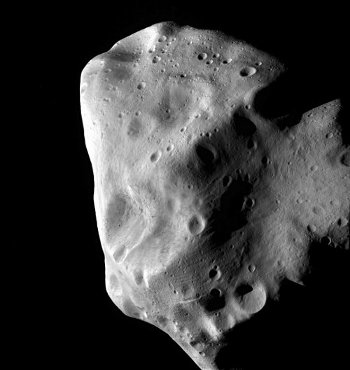
The observations pulled together data in visible, ultraviolet, near-infrared and mid-infrared wavelengths. The only kind of meteorite that matches the spectrum of Lutetia exactly is the type known as enstatite chondrites, known to be material from the early Solar System, and thought to have been a major constituent in the formation of the Earth, Venus and Mercury. Isotope measurements of enstatite chondrites show that they are the only groups of chondrites that have an isotopic composition that is the same as that of the Earth and Moon, and their chemistry and mineralogy supports the idea that they formed close to the Sun. Mercury seems to have accreted from these materials.
Image: New observations indicate that the asteroid Lutetia is a leftover fragment of the same original material that formed the Earth, Venus and Mercury. Credit: ESA/Rosetta.
If Lutetia formed in the inner system, it would be a part of the less than 2 percent of bodies located in the region where the Earth formed that wound up in the asteroid belt. So in this case we have not a planetary ejection, but an asteroid migration, the movement of an object about 100 kilometers across that was propelled outward through an encounter with one of the inner planets. The migration scenario could involve more than just the rocky planets of the inner system, as the paper on this work notes:
The question naturally arises as to how Lutetia escaped accretion into one of the terrestrial planets and ultimately reached the main belt. The dynamical mechanism is likely to be similar to the one explaining the origin of iron meteorites as remnants of differentiated planetesimals formed in the terrestrial planet region… Extended dynamical simulations reveal that, at the time when terrestrial accretion was ongoing, a small fraction (<2%) of the planetesimals residing in the 0.5-1.5 AU region were scattered out by emerging protoplanets… and/or by the migration of Jupiter… and achieved main-belt orbits, thus becoming dynamically indistinguishable from the rest of the main-belt population.
But Lutetia would be carrying evidence for a far different interior than most asteroids:
According to this scenario, planetesimals of the size of Lutetia (D ~ 100 km) that formed in the 0.5-1.5 AU region experienced significantly more heating by short-lived nuclides than asteroids formed in the main belt. A direct consequence is that most of these planetesimals are likely to be differentiated in accordance with iron meteorites having formed in this region.
All of this adds to the buzz about an asteroid that, in terms of color and surface properties, was already considered unusual. It wasn’t long ago that we discussed Lutetia’s once having had a hot metallic core, based on evidence from the Rosetta encounter in July of 2010. The suggestion was that although it had a battered, unmelted surface, Lutetia may have had a differentiated interior, making it a primordial planetesimal. That would make it a highly interesting relic of the period of planetary formation, and the new work adds to the case for more intense study of the asteroid, as ESO’s Pierre Vernazza, lead author of the paper on the new work, comments:
“Lutetia seems to be the largest, and one of the very few, remnants of such material in the main asteroid belt. For this reason, asteroids like Lutetia represent ideal targets for future sample return missions. We could then study in detail the origin of the rocky planets, including our Earth.”
The paper is Vernazza et al., “Asteroid (21) Lutetia as a remnant of Earth’s precursor planetesimals,” accepted for publication in Icarus (preprint).

